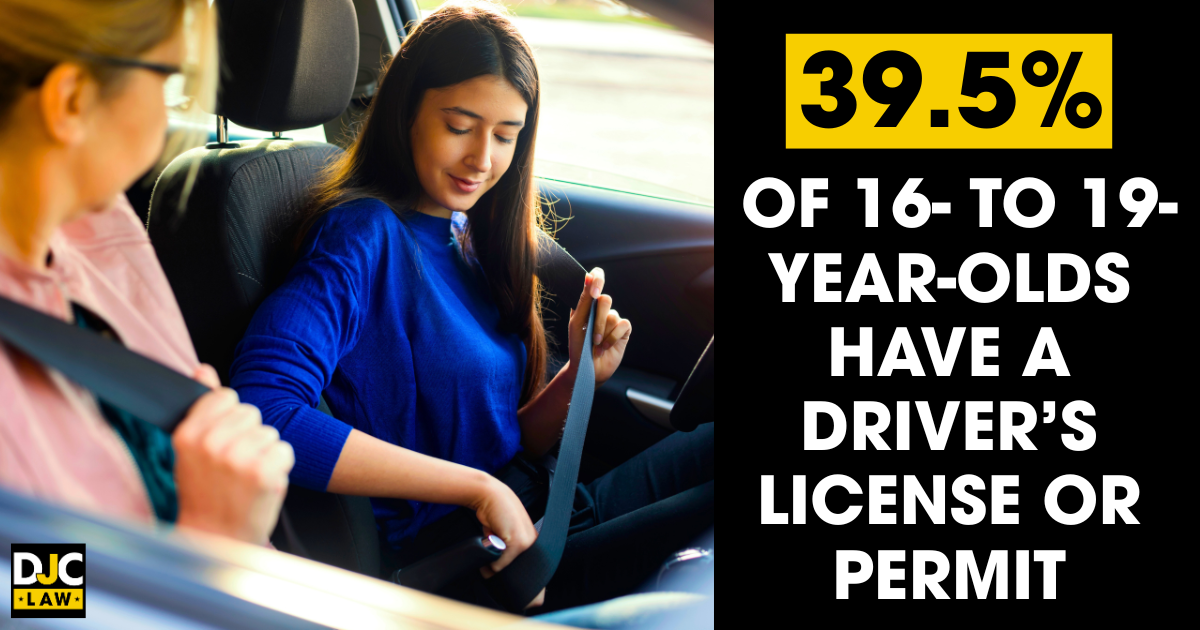Learning to drive is an exciting time. Any teen starting their respective state’s Graduated Driver Licensing (GDL) program is well on their way to embracing the freedom of their own set of wheels.
Today, the U.S. Department of Transportation reports that 39.5% of teens aged 16 to 19 have some form of permit or license. But can you drive in another state with anything less than a full adult driver’s license? The answer is that it depends on the state.
With the Federal Highways Administration reporting up to 2.8 million licenses and permits issued annually, it’s a common topic of confusion. In this guide, we clear the air to help you and your family know where you stand on crossing state lines. If an accident happens while driving out of state, contacting an experienced Austin car accident lawyer can help you navigate any complex legal issues that may arise.

Key Takeaways
- A learner’s permit is the entry point of the Graduated License Program (GDL), allowing teens to learn how to drive under the supervision of a fully licensed adult, including those with an instruction permit.
- Most states allow learner’s permit holders to cross state lines, but drivers must adhere to the rules and regulations of that state.
- Some states also require learner’s permit holders to follow their home state’s rules. Drivers should always conform to the stricter of the two rules where there’s a conflict.
- Learner’s permit holders are legally required to follow the rules of any state they drive to, including any states they cross on the way. The supervising driver is legally responsible for the driver they’re supervising.
- Common restrictions imposed on permit holders include night-time curfews, passenger limits, and the age of the supervising driver.
- Permit holders who get into car accidents out-of-state will be dealt with under the rules of the state where the accident occurred, not their home state.
- If you were involved in a car accident in another state, contact an experienced personal injury lawyer locally to handle your claim.
What is a Learner’s Permit?
A learner’s permit is an entry-level license for teenagers who want to begin driving. In Texas, the minimum age for applying for and receiving a state learner’s permit is 15 years old, and it will expire on your 18th birthday.
According to the Texas Department of Licensing and Regulation, all permit holders can only drive if there’s an adult with a valid driver’s license who’s at least 21 years old. Moreover, they must remain in the passenger seat next to the driver at all times.
So, whether you’re driving inside Texas or going on a road trip to another state, you can’t drive alone with a valid learner’s permit.
State-Specific Regulations for Driving With a Permit
Each state maintains its own Graduated Driver Licensing (GDL) programs, with each state setting its own requirements, including the minimum driving age. These programs aim to provide a structured framework for drivers to ease into learning before they’re let loose with a full adult driving license.
Unfortunately, every state has its own rules regarding whether your learner’s permit is recognized and the rules that apply to you. Before going anywhere outside of Texas, you must familiarize yourself with the rules of the destination state and any state you might pass through along the way.
Legal Considerations for Out-of-State Driving
The federal government doesn’t protect learner’s permits as rights, whether it’s a conventional or a motorcycle license. Instead, they’re driving privileges offered by each state, and that means you’ve got several legal considerations to consider, including passengers, the supervising driver, and insurance coverage.
All drivers with a permit from another state must conform to the restrictions placed on their learner’s permits and the traffic laws of that state. Being from Texas with a Texas learner’s permit doesn’t offer any protections or exemptions when crossing state lines.
Another issue is the supervising driver. The supervising driver must be fully licensed and at least 21 in Texas. It’s a requirement that applies to most states but not all.
For example, if you’re taking a road trip from Dallas to Los Angeles with a 21-year-old fully licensed driver, you would have zero problems crossing into New Mexico and Arizona, but California’s minimum age requirement for the supervising driver is 25.
Another legal consideration is insurance coverage. Your auto insurance policy must cover out-of-state driving. If you’re using a family policy while you learn, it may not provide coverage that extends to supervised driving out-of-state, meaning if you leave the state, you’re basically uninsured.
The best way to handle this issue is to check the regulations for every state you’ll be driving in. Don’t make the mistake of assuming that what’s good in Texas is good everywhere else.
Reciprocity Agreements Between States
Reciprocity agreements between states allow for mutual recognition of learner’s permits. However, most states don’t have any formal agreements that explicitly apply to learners’ permits. Instead, it’s a form of informal recognition.
The web of interstate laws regarding learner’s permits is held up by holding a similar set of requirements, chiefly:
- Following the rules of the state they’re driving in.
- Being accompanied by an adult with a valid license.
- Supervision of a licensed adult who meets that state’s age requirement.
Unfortunately, there’s no uniformity between states and no national standard that governs this, hence why the requirements are often so complicated. The same cannot be said for full driver’s licenses, which are governed under the Driver License Compact (DLC).
What to Do If Pulled Over in Another State
Getting pulled over outside of your home state as a teen is stressful. What matters is that you have the appropriate documentation and remain calm throughout the situation. Most traffic stops are routine stops designed as inspections of traffic with out-of-state license plates.
Follow these tips for how to act if you’re pulled over:
- Stay Calm – Pull over where it’s safe, switch off the engine, and always keep your hands visible.
- Provide Documentation – Traffic officers will usually ask for your permit, the license of the supervising adult, proof of insurance, and motor vehicle registration. Occasionally, you may be asked how you know the supervising driver.
- Explain the Situation – Mention that you’re from another state and have asked about the local laws. If the officer wants to argue that your permit isn’t valid or you’re breaking the rules, don’t argue.
- Call for Help – If you’re a minor and the supervising adult isn’t a licensed parent or legal guardian, you may be asked about them. Be prepared to get in touch and put them on the phone to allow the officer to speak to them.
- Follow-Up – Most of the time, the officer will send you on your way, but if you’ve been issued a citation, ensure you get proper legal representation. Simply going back home again won’t make the issue go away and will only result in legal consequences.
If you believe that you’ve been issued a citation unjustly, contact an experienced attorney to discuss your case. Explain the situation to them, and they’ll be able to advise you on what you can do to fight the citation.
Permit Holder Responsibilities While Traveling
Complying with another state’s requirements, including traffic laws, is entirely your responsibility. Ignorance, because you’re resident elsewhere, isn’t a defense, and you could get yourself into difficulties if you don’t assess each state’s rules in advance.
Many people will look up the rules of the state where they’re going but forget to do the same with every state they pass through along the way. To further complicate matters, some states require you to follow your own state’s rules and the other state’s rules.
Granted, you may question how another state’s traffic officers can enforce the laws of a state they aren’t familiar with, and you’d be correct, but that doesn’t mean you shouldn’t obey the rules at every turn, regardless. Texas is one such state that places this legal obligation upon its learner’s permit holders.
So, what happens if you’re in this situation? The answer is that you follow the stricter rule. For example, West Virginia places a night-time curfew between 10 pm and 5 am, but Texas’ curfew is between midnight and 5 am, so in this case, you’d follow Oklahoma’s rules.
On the other hand, New Hampshire’s night-time curfew begins at 1 am and lasts until 5 am. In this case, Texas learner’s permit holders should still follow the Texas cut-off time at midnight to comply with the law.
Other than these legal quirks, ensure that you always carry your documentation and stick to the side of caution when driving in unfamiliar conditions.
Understanding Your Limitations as a Permit Holder
Permit holders don’t have the rights and privileges of a full driving license. Your freedom to drive depends entirely on the restrictions each state places on you. You must always obey the rules and regulations of your state or the stricter regulations that Texas places on you.
Some of the most common limitations to be aware of before you drive include:
- Supervising Driver Age – All states require out-of-state drivers to have a supervising driver, but the age limit differs. In most states, it’s 21, but California has a limit of 25, whereas Montana has a much lower limit of 18.
- Driving Curfews – States are entitled to impose night driving curfews. Texas’s curfew is midnight, and you can only drive again after 5 am, with exceptions like medical emergencies. Other states may have stricter or more lenient curfews.
- Passenger Limits – Some states may limit who can travel as a passenger when a permit holder operates a car. For example, Texas allows you to carry one passenger under the age of 21, whereas both Maryland and Massachusetts prohibit any passenger under 18. In contrast, New York varies by region.
Breaking any of these rules means opening yourself up to a traffic citation, problems with your auto insurance coverage, and potential delays in getting your provisional and full adult driving license later.
Importance of Adult Supervision in Different States
Adult supervision is a legal requirement in every state because a learner’s permit is specifically designed to allow minors to operate a car with a supervising adult. Extra supervision also provides a guiding hand to prevent you from making any catastrophic errors.
Remember, a supervising adult isn’t a silent bystander. The supervising adult takes legal responsibility for ensuring that you follow the rules. If you get pulled over and receive a citation or you’ve caused an accident, the supervising adult can also be punished because the permit holder is their responsibility.
Crossing state lines as a permit holder also opens you up to brand-new driving conditions. As an inexperienced driver, tight roads, fast-moving traffic, complicated intersections, and inclement weather will put your skills to the test.
The benefit of a supervising adult doesn’t just come in the form of advice but also a chance for them to take over if you need a little help negotiating the situation.
Real-Life Scenarios: Driving Across State Lines
In an ideal world, the rules outlined for out-of-state drivers on learner’s permits would stay the same in every scenario, but this isn’t the case. You may encounter different scenarios where the rules change.
Here’s an outline of three common real-life scenarios you might encounter and what it could mean if you cross state lines.
Scenario One: Traveling on Family Trips
Embarking on a family trip might seem like an ideal time to share driving responsibilities and gain experience.
The problem is that most states restrict how many passengers you can carry. For example, you can have a supervising driver and one adult passenger in many states, but if you have other minors in the back, you may be prohibited from using your learner’s permit to drive in that state.
Some states may make exceptions for direct family members, but this isn’t a given, so check the restrictions of every state you want to drive in first.
Scenario Two: Moving to a New State With Your Permit
Moving to a new state permanently means you’re switching your state residency. Your Texas learner’s permit will no longer be valid after a certain period because you’re no longer resident there.
Most states will require you to exchange your learner’s permit within 30 to 90 days of becoming a resident there. Depending on the state, you might have to retake any written or skills tests you’ve already taken to get a new permit. Look into the issue by contacting the DMV office of your new state.
Note, this isn’t an issue exclusive to permit holders. Adult holders with a full legal license must also convert their licenses to their new state.
Scenario 3: Attending College Out of State
Attending college out of state is a tricky one because it depends on whether you’re becoming a resident there. Most states require you to spend at least a year there, meaning students often must avoid going home for summer vacation to acquire residency.
If you plan to switch your residency to your college state, you should follow the same guidelines as becoming a new resident. If you’re not switching residency, your existing learner’s permit will likely remain valid, but it depends on where you’re moving to for college.
Insurance Considerations for Permit Holders
Learner’s permit holders must follow the same auto insurance rules as everyone else because they’re still operating a vehicle on public roadways. You don’t necessarily need your own separate policy, but must be covered by some form of insurance that meets the state’s minimum requirements.
Don’t assume that coverage is automatically extended to a learner’s permit holder. Many insurance companies require you to be formally listed for coverage to apply.
Do You Need Special Insurance Coverage?
Special insurance coverage isn’t necessary for a learner’s permit holder. You can be added to an existing policy (usually at no cost until you’re fully licensed), covered automatically by a familial household policy, or take out your own standalone policy.
Generally, the best way to deal with this is to call your insurer to find out whether learner’s permit holders are automatically covered or if they need to be formally listed. If it’s the former, you can rest assured that you’re already protected insurance-wise.
Implications of Driving With a Permit on Your Family’s Policy
Covering a teen driver with a learner’s permit isn’t for every family. Parents and guardians should familiarize themselves with the implications of having a permit holder on their family policy.
Generally, here’s what it means:
- Auto Insurance Premiums – Insurers don’t usually raise rates because you’ve got a valid permit holder on your policy. Instead, the premiums go up after they receive their full licenses.
- Liability – Teens are covered under their family policies if they get into an accident. However, if this happens, you can expect your premiums to rise accordingly.
- Permit Violations – Permit holders who don’t follow the rules, such as driving after curfew without a valid reason, may see any claims denied or payouts limited. That could leave parents and guardians paying out-of-pocket.
If you’re wondering whether you want a permit holder on your policy as a parent, it’s not a risk-free play. Ask yourself whether your teen is mature enough to follow the rules, and if you’re unsure, have them pay for a standalone policy for themselves.
What Happens if You’re in a Car Accident While Driving Out of State?
If you’re involved in an accident in another state, the rules of that state automatically apply. Traffic officers in the state where you had the accident will judge who was at fault based on their laws, not Texas’.
It’s the convention in every state. In Texas, it’s known as the Non-Resident Motorist Act and has been enshrined in the Texas Transportation Code Chapter 601. It states that an out-of-state permit driver can be held liable, and it will be up to a Texas court to judge under state law.
Understanding Liability and Fault Across State Lines
Where you live has no impact on accident liability. After an accident, liability is always determined by where the accident happened, and that system will apply. This matters if you’re filing a claim or a lawsuit.
Texas is an at-fault state operating under comparative negligence laws. Under the 51% bar rule, you're barred from receiving monetary compensation if you’re 51% or more responsible for an accident. But if you have an accident in a pure contributory negligence state like Alabama, even being 1% at fault will prevent you from claiming compensation.
Legal Support for Permit Holders Involved in Out-of-State Accidents
Local law rules any personal injury lawsuit or insurance claim after an accident. If you require legal support after getting involved in an out-of-state accident, you should hire a local attorney who understands the laws of that state.
An attorney in your home state can offer support and advice, but they can’t fight your case in another state because they won’t know how their system operates. What they can do is recommend local legal representation, as many law firms have practices in multiple states, including DJC Law.
If you’re an out-of-state driver who’s gotten into a car accident in Texas or a Texas driver who’s been involved in an accident in a state where DJC Law is present, we can help. With over $400 million in settlements won and a 99% case win rate, we’re best placed to fight your case, defend your legal rights, and give you peace of mind.
To learn more about how we can help, contact DJC Law for your free consultation today.


